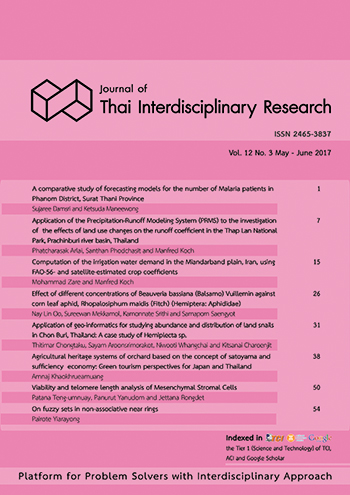Application of geo-informatics for studying abundance and distribution of land snails in Chon Buri, Thailand: A case study of Hemiplecta sp.
Main Article Content
Abstract
The land snail is the only group of invertebrate in Phylum Mollusca that has evolved in terrestrial ecosystems successfully. Current environmental issues, e.g. climate change, natural disasters, pollution, and human-encroachment activities so their population decreases rapidly. More importantly, Hemiplecta sp. is a biodiversity indicator and plays a key role in the food chain and land snails meat contains a high level of nutrients and is a source of protein, similar to poultry, pork, and beef that are nutritionally suitable for consumption. As result, spatial analysis of geo-informatics data of Hemiplecta sp. displayed on a map where the color coding is based on 7 factors of habitats (elevation, landform, geology, water resource, forest, temperature, and relative humidity) and ranked by the amount of suitability of the area from high (S1), medium (S2), and low (S3) using Potential Surface Analysis (PSA) method. The results show that Chon Buri has 270, 411, and 1,166.3 square kilometers for S1, S2, and S3 respectively and the overall of the analysis was 65 percent. The distribution of Hemiplecta sp. is topographic dependent of environment and physical indicators found in the area, namely Bo Thong, Ko Chan, Siracha, Bang Lamung, Nong Yai, Ban Bueng, Satthahip, and Mueang Chon Buri. Furthermore, this research will be useful for the management of resource conservation and supporting trade, and food alternatives in case of a shortage of sustainable food in the future.
Article Details
How to Cite
Chongtaku, T., Aroonsrimorakot, S., Whangchai, N., & Charoenjit, K. (2017). Application of geo-informatics for studying abundance and distribution of land snails in Chon Buri, Thailand: A case study of Hemiplecta sp. Interdisciplinary Research Review, 12(3), 31–37. https://doi.org/10.14456/jtir.2017.18
Section
Research Articles


